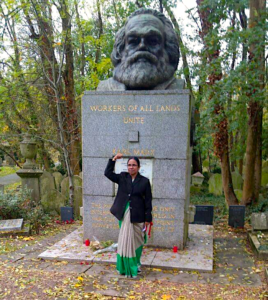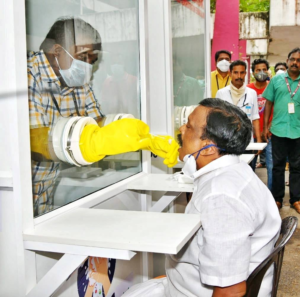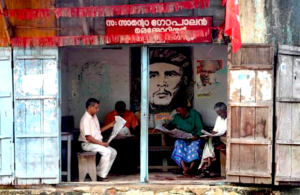Cover Image: A community kitchen in Kerala
Journalists in the mainstream Western media often show surprise even as they report on governments in the Global South navigating the COVID-19 pandemic with relative success compared to the chaos in the U.S. and UK. But the success story that they narrate is typically one of individual leadership or culture, as if individuals and cultures are not embedded in political spaces. This article is about Kerala, a state in the southern part of India that elected the world’s second democratically elected communist government in 1957. Kerala is currently governed by the Left Democratic Front led by the Communist Party of India (Marxist).
Kerala has rightfully received many accolades in the past few months for its relative success in handling the pandemic. K.K. Shailaja, lovingly addressed as Shailaja Teacher, is minister of health and social welfare in Kerala. Many news outlets have called Shailaja Teacher the ”rock star health minister“ and “corona slayer“ for her leadership in tackling the COVID-19 pandemic. This communist woman’s press conferences will not get the same kind of adulation that Andrew Cuomo receives even though the New York governor did not take the pandemic seriously enough during the critical period at the beginning of the outbreak. But for those who understand Malayalam (the regional language of Kerala), Shailaja Teacher and her team’s press conferences exude confidence and trust among Kerala’s citizens.

As on July 4, Kerala, a state with a population of 34.8 million people, has reported 5,204 positive cases and 25 deaths. Every death is unfortunate. Yet, Kerala has been relatively successful in constraining the spread of the virus as compared to other states in India and even some of the Western nations. These numbers are especially impressive, as Kerala is one of the most globalized states in India as a tourist destination and because many Keralites work outside the state.1 Of the 5,204 cases, 88 percent of the positive cases are categorized as “Import” — cases identified among people who traveled to Kerala — and only 12 percent of the cases as transmitted through domestic contact.2 This suggests that the state has been successful in putting in place effective protocols to test, trace and isolate affected people. As many experience job losses because of the pandemic, it is expected that more people may return to Kerala, but the government has said that it is prepared.3 What did Kerala do right?
There are two ways to answer this question. One, by focusing on the immediate response of the government, and two, by examining the political history in Kerala that enabled the government to respond appropriately at the time of the crisis. As Shailaja Teacher herself has attested, the long history of social mobilization, empowered decentralized governance structures, educational reforms, and social reforms are central to this success story. Kerala’s social mobilization history includes anti-caste movements, the anti-colonial movement, and agrarian protests. As Heller (2005:85) argues, “None of these movements, taken alone, was unique to Kerala. But to the extent that they converged both ideologically and organizationally under the political leadership of a programmatic cadre based communist party, they generated a socially transformative dynamic that has taken Kerala down a very different path from the rest of the country.”
Immediate response to the pandemic
Kerala identified the first positive case of corona virus infection on Jan. 30, 2020. The first three positive cases were Indian students returning from Wuhan, China. By February 4, Kerala declared the epidemic a state calamity4, much before WHO declared COVID-19 as a pandemic5 on March 11. In contrast, the U.S. identified its first case on Jan 21, while international travel continued without testing and contact tracing till March 19. New York, the epicenter of the pandemic in the U.S., issued a stay-at-home order only on March 22.
Kerala, under the leadership of Shailaja Teacher, had recently navigated another deadly viral infection in the form of the Nipah virus in 2018. Taking lessons from the Nipah outbreak, the health ministry immediately put in place protocols for contact tracing and isolation of people infected by the virus, especially those traveling into Kerala. Further, through consistent and transparent communication and media campaigns such as “Break the Chain,” the Kerala government continued to educate the public on appropriate practices. Kerala’s scientific response to the pandemic was miles ahead of many Western nations that were short-sighted enough to prioritize the economy over human well-being, and in the process severely affecting the economy as well. As many others have said before, the initial period is critical to flatten the curve so that the health care system is not overwhelmed by an unexpected number of patients. By getting ahead of the curve during the early days of the pandemic, the Kerala government was able to curtail the fast spread of the infection.

While contact tracing, testing, and clear communication is important, a lock-down that does not consider the survival needs of people may not be successful in sustaining physical-distancing practices. The Kerala government home-delivered free groceries to families and created community kitchens to provide cooked food packets for those who were disproportionately affected by the pandemic, such as homeless people and guest workers (the term that the Kerala government uses to refer to migrant workers).
The community kitchens are organized by local self-governing bodies along with women involved with the government’s poverty alleviation project known as Kudumbashree.6 The effort was to ensure a Hunger Free Kerala During Lockdown.7 Besides food, the Kerala government also organized psychological and social support for people with mental health needs, children with special needs, elderly people living alone, and guest workers.8 Given how the lock-down and quarantine often results in increasing instances of domestic violence, the government also launched a WhatsApp helpline for women to report domestic violence incidents.9
What enabled such a response?
While the proactive, humane, and scientific response from the Kerala government in the face of the global pandemic in 2020 is impressive, much of the news reporting has not paid attention to why such a response was possible. Pinarayi Vijayan, chief minister of Kerala, attributes the success to the historical project of decentralized governance that emerged under the Communist rule:
“Historically, Kerala has had a strong system of decentralized governance. … As a result, there is considerable community participation in the planning process, which has enriched the decentralization of power. It is this strong system of participatory governance that has helped Kerala in the containment measures related to the COVID-19 pandemic. A state or central government can give broad directions and guidelines but people’s participation under the leadership of empowered local governments seems to be the most effective strategy to contain the spread of COVID-19. At the same time, a strong public sector in health and education is necessary for this decentralized model to work well.”
In India, developmental responsibilities of the state, such as identifying beneficiaries for welfare initiatives, evaluating specific local needs, and executing welfare programs at the local level are realized through local self-governments. However, in many other states, local self-government bodies are not empowered with financial and administrative power. The Left Democratic Front launched a radical experiment between 1996-2001, known as People’s Campaign for Decentralized Planning, which committed to fiscal, administrative, and political decentralization to local self-governments (Isaac and Franke 2000). The government invested in training and empowering local self-governments to participate in the planning process, while providing financial resources (35-45 percent of the planning budget) to support those plans. Funding also included specific allocations for marginalized caste communities and women (Isaac and Franke 2000). In contrast to what is often implied in the U.S. about communist parties, the Left Democratic Front in Kerala was committed to deepening democracy in the state.
Why does decentralized governance matter to COVID-19 pandemic? Protocols related to contact tracing has been one of the hallmarks of the Kerala model of responding to the pandemic. Journalists also refer to the civic consciousness in Kerala, which activated a seamless communication between the state and citizens at the time of the crisis. But neither the possibilities for contact tracing nor civic consciousness is an automatic outcome. While the decentralization experiment is said to have mixed results in some areas, benefits were visible in health care, education, and public health initiatives such as water, sanitation, nutrition, and health education campaigns. Empowerment of local self-governments has created a decentralized public health care system. People have access to a functioning public health center within two miles from their villages with contact details of local community health workers.10 Public health centers were particularly effective in contact tracing, monitoring, and providing basic consultation for those who tested positive but did not have severe symptoms. Patients with advanced symptoms could then be referred to higher levels of the health care system where they were quarantined and treated.
A decentralized governance structure has also contributed to creating a vibrant civic society in Kerala. Studies have shown that the People’s Campaign enabled a rise in volunteerism and innovative problem-solving in the state (Elamon et.al 2004). The role of social movements, particularly that of Kerala Sasthra Sahithya Parishad (KSSP)11, which is a people’s science movement, has also been influential in enhancing a scientific temper among citizens. Although it is an autonomous association, KSSP has shared the mass mobilization politics and democratic goals of the Communist party, but has also challenged government projects that they evaluated to be detrimental to the environment (Heller 2005). A combination of social movement mobilizations and decentralized structures has helped develop a political culture where people are actively involved in the governance of their state. Currently, the Kerala government has institutionalized its volunteer base through its Social Volunteer Force, where 346,517 people from within and outside the state have enrolled as volunteers.12 The power of such a vibrant, committed volunteer force was also visible during the massive floods that devastated the state for days in 2019.

For many, this photograph of a reading room is an iconic representation of how education and politics come together in people’s everyday lives in Kerala.
While not perfect, the Kerala model demonstrates the potential of a state that responds to a pandemic in a humane, proactive and scientific manner. However, such a response does not appear magically on the eve of a crisis. It emerges out of a deep commitment to mass mobilization, democracy, and public institutions.
References:
Heller, Patrick. 2005. “Reinventing Public Power in the Age of Globalization” Pp. 79-106 In Social Movements In India: Poverty, Power and Politics edited by Raka Ray and Mary Fainsod Katzenstein. Maryland:Rowman & Littlefield Publishers.
Elamon, Joy, Richard.W. Franke, and B. Ekbal. 2004. “Decentralization of Health Services.” International Journal of Health Services 34(4):681-708.
2 https://dashboard.kerala.gov.in/testing-view-public.php
3 https://www.youtube.com/watch?v=_1AQbgoG
4 https://www.onmanorama.com/news/kerala/2020/02/03/coronavirus-kerala-state-emergency.html
5 https://www.who.int/emergencies/diseases/novel-coronavirus-2019/events-as-they-happen
7 https://dashboard.kerala.gov.in/ck-view-public.php
8 https://dashboard.kerala.gov.in/psycosocial.php
10 https://frontline.thehindu.com/cover-story/article31404326.ece
11 https://en.wikipedia.org/wiki/Kerala_Sasthra_Sahithya_Parishad




